BT Cloud Phone
Set up BT Cloud Phone Integration
BT Cloud phone is a cloud-based phone system designed for small businesses that want all the features of a system without running one. With the BT Cloud phone, you can take your office out on the road with you. Once you integrate BT Cloud Phone with Zoho CRM, you can do the following.
- When you receive an incoming call from or initiate an outgoing call to a CRM contact via BT Cloud Phone, you can see a business card view of the contact in Zoho CRM.
- All calls made or received via BT Cloud Phone are automatically logged in Zoho CRM and you can view the call logs.
- You can add follow-up activities at the end of every call from Zoho CRM.

- For this integration to work, you must have a BT Cloud Phone account.
- You must also have the BT Cloud Phone softphone installed in your device.
- Only an Administrator of a Zoho CRM account can enable the BT Cloud Phone Integration.
- Once enabled by the Administrator, the integration is activated for all users. Every user in the Zoho CRM Organization account can log in to BT Cloud Phone with their unique credentials.
To configure BT Cloud Phone in Zoho CRM, you must
- Enable BT Cloud Phone integration
- Log in to your BT Cloud Phone account in Zoho CRM
Enable BT Cloud Phone Integration
To enable BT Cloud Phone Integration
- Go to Setup > Channels > Telephony.
- Select BT Cloud Phone from the Choose a telephony provider drop-down list.
- Click Enable.
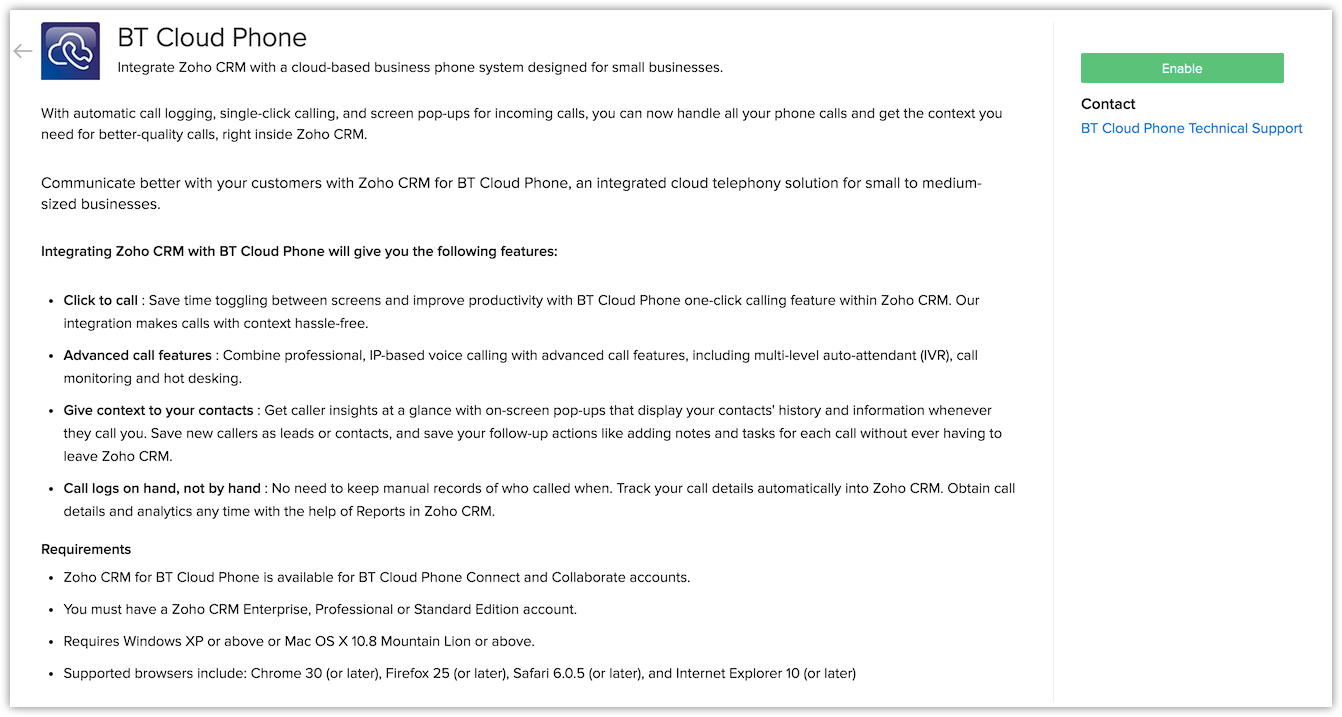

- After clicking Enable, please wait while the page refreshes automatically. Do not click anywhere else until the BT Cloud Phone Login screen appears.
Log in to BT Cloud Phone
Once you have enabled the BT Cloud Phone integration, you will be prompted to log in to your BT Cloud Phone account from Zoho CRM.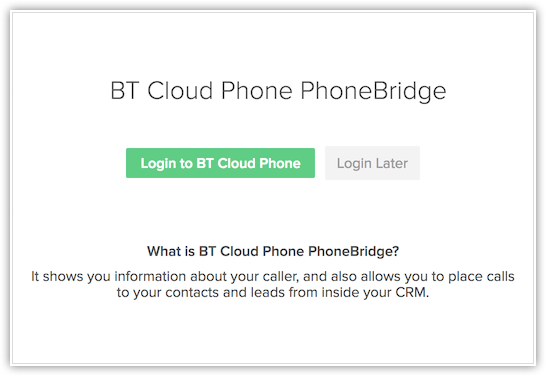
To log in to your BT Cloud Phone account
- Click Login to BT Cloud Phone if you wish to log in to your account right away.
- You will be navigated to BT Cloud Phone Login page where you need to enter the login details and click Login.
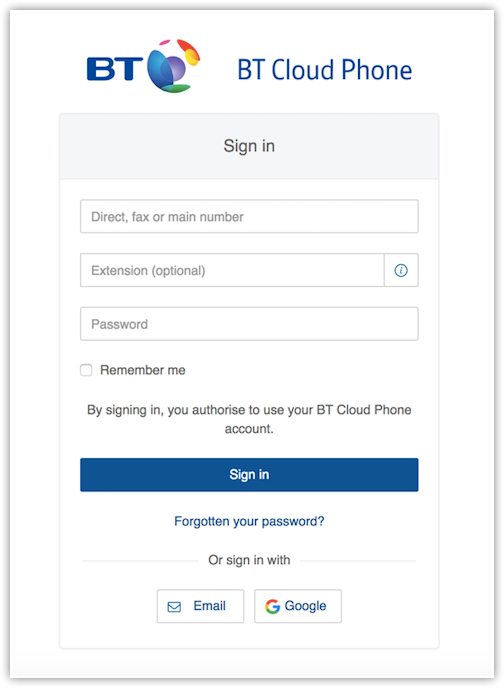
-
If you are logging in later, you can use the Phone icon at the bottom right of the page to access the BT Cloud Phone Login screen.
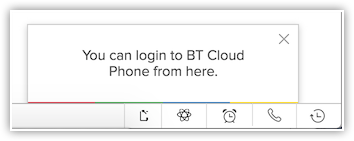
-
Once you login, choose the required phone number from the available list. Please use your direct BT Cloud Phone number of your organization.
Use BT Cloud Phone Integration
Once you have enabled BT Cloud Phone in Zoho CRM and logged in to your BT Cloud Phone account in Zoho CRM as well as the BT Cloud Phone softphone, you are ready to use this BT Cloud Phone integration.You can receive incoming calls, initiate outgoing calls and add follow-up activities from Zoho CRM.
Receive calls
When you receive an incoming call from a CRM contact via BT Cloud Phone, you can see a Business Card view of the contact.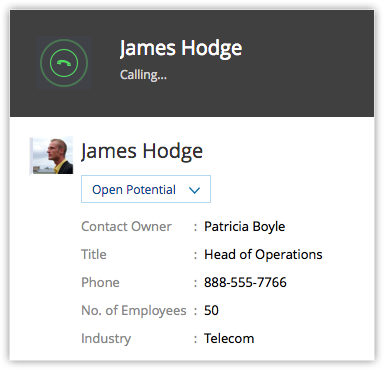
At the end of the call, the follow-up options on the Call Ended window lets you add calls and assign tasks to your contact.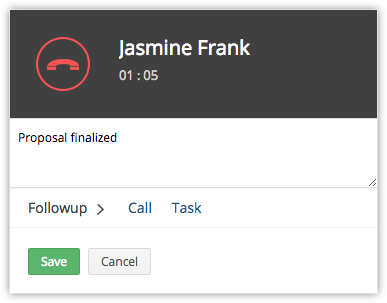
Make Calls
When an outgoing call is initiated to a contact in Zoho CRM, the call is made via BT Cloud Phone.
To initiate an outgoing call from Zoho CRM
- Click the desired record.
-
In the Record's Details page, click the Phone icon beside the phone number.
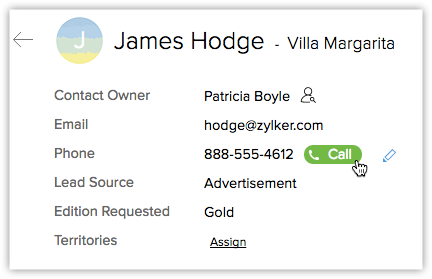
The call via BT Cloud Phone is now established.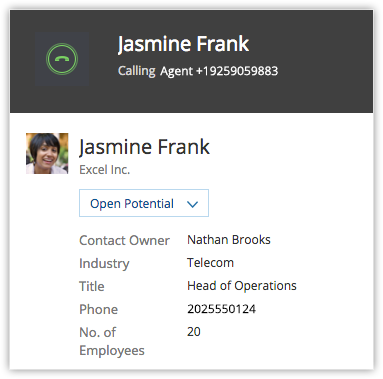
- The follow-up options on the Call Ended window lets you add calls and assign tasks and add a call description.

Follow-up Activity
At the end of every call via BT Cloud Phone, you can do any or all of the following activities from the Call Ended window in Zoho CRM. These would automatically be associated to the respective record.
- Add a follow-up call.
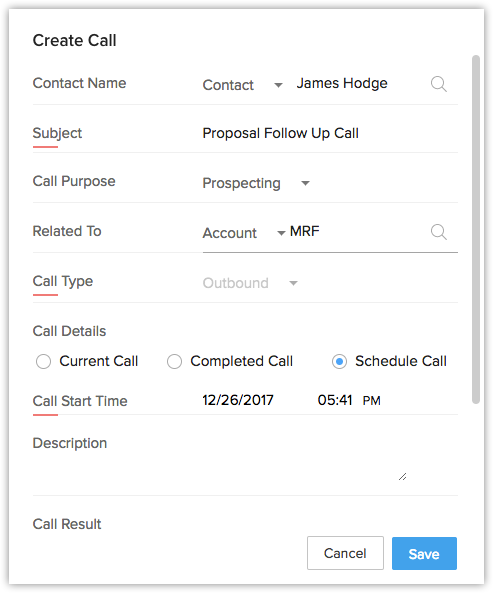
- Add a follow-up task.
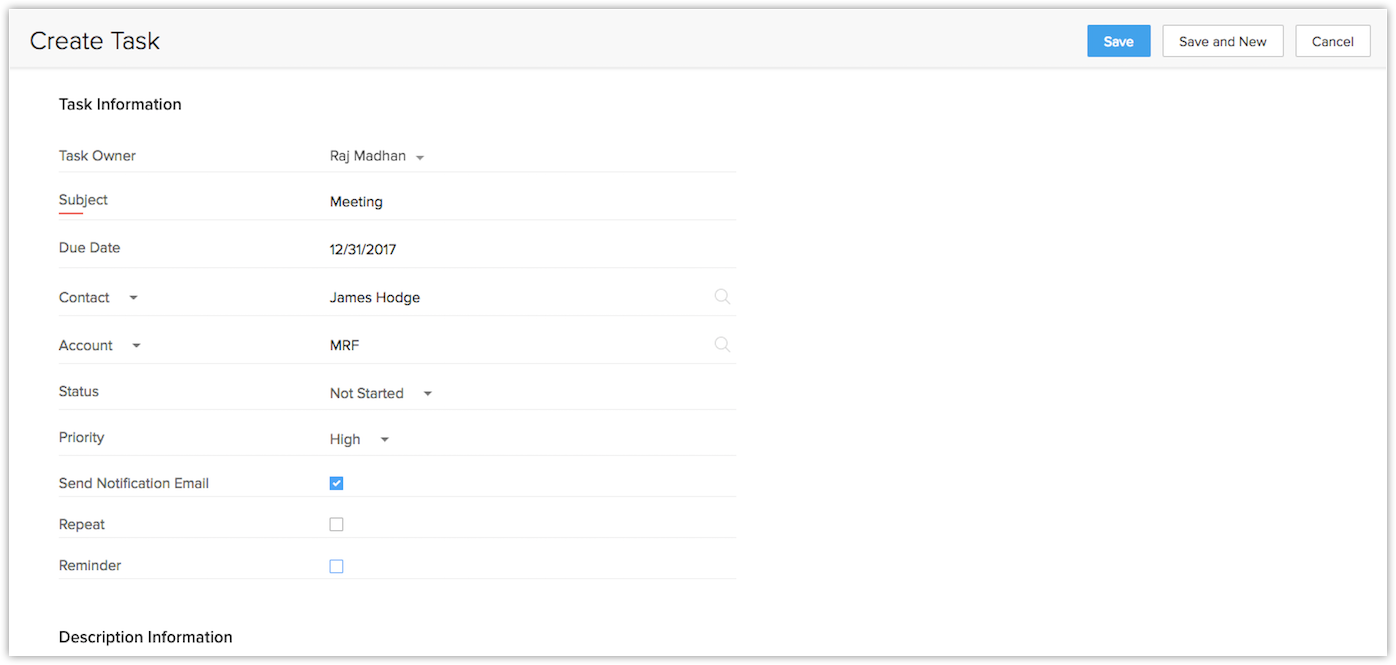
View Call Logs
Calls made, received, missed and unanswered in Zoho CRM via BT Cloud Phone are automatically logged in the Calls module.
To view call logs and Call Recordings
- Click the Calls module.
- Select the All Calls list view.
- Click on any desired record to view the call details.
- Recorded calls are displayed in this section.

- The recorded calls can only be viewed if BT Cloud Phone integration is enabled and the user is logged in.
- In case the preferred phone number for calling is selected as "{company_number}*{extension}", then the calls module would show two records for each call made from CRM.
BT Cloud Phone Browser Calling
Browser calling for BT Cloud Phone allows you to make calls directly from CRM without having to toggle between your CRM account and BT Cloud Phone. WebRTC plugins are installed to give hassle-free browser calling and a real-time communication will be established with the end user.
You need to choose the Browser option from the call preferences pop-up to make calls through your browser. You can also save your preferences along with the outbound Caller ID of the recipient, so that you can easily identify your callers to your BT Cloud Phone numbers while making outbound calls.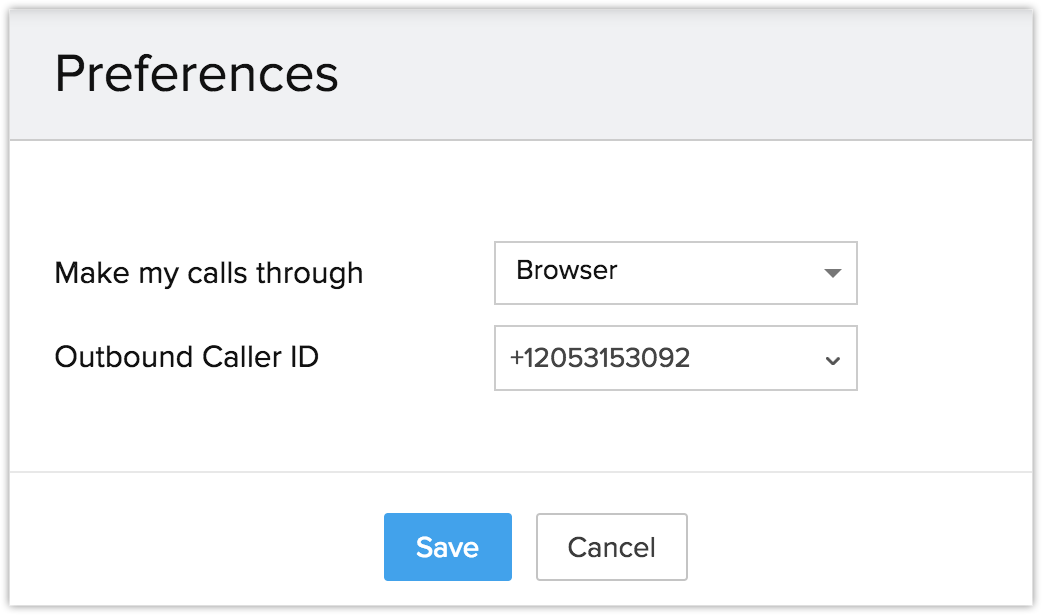
You can now make calls directly from your browser without having to use a softphone. This also allows you to directly attend the incoming calls within your CRM.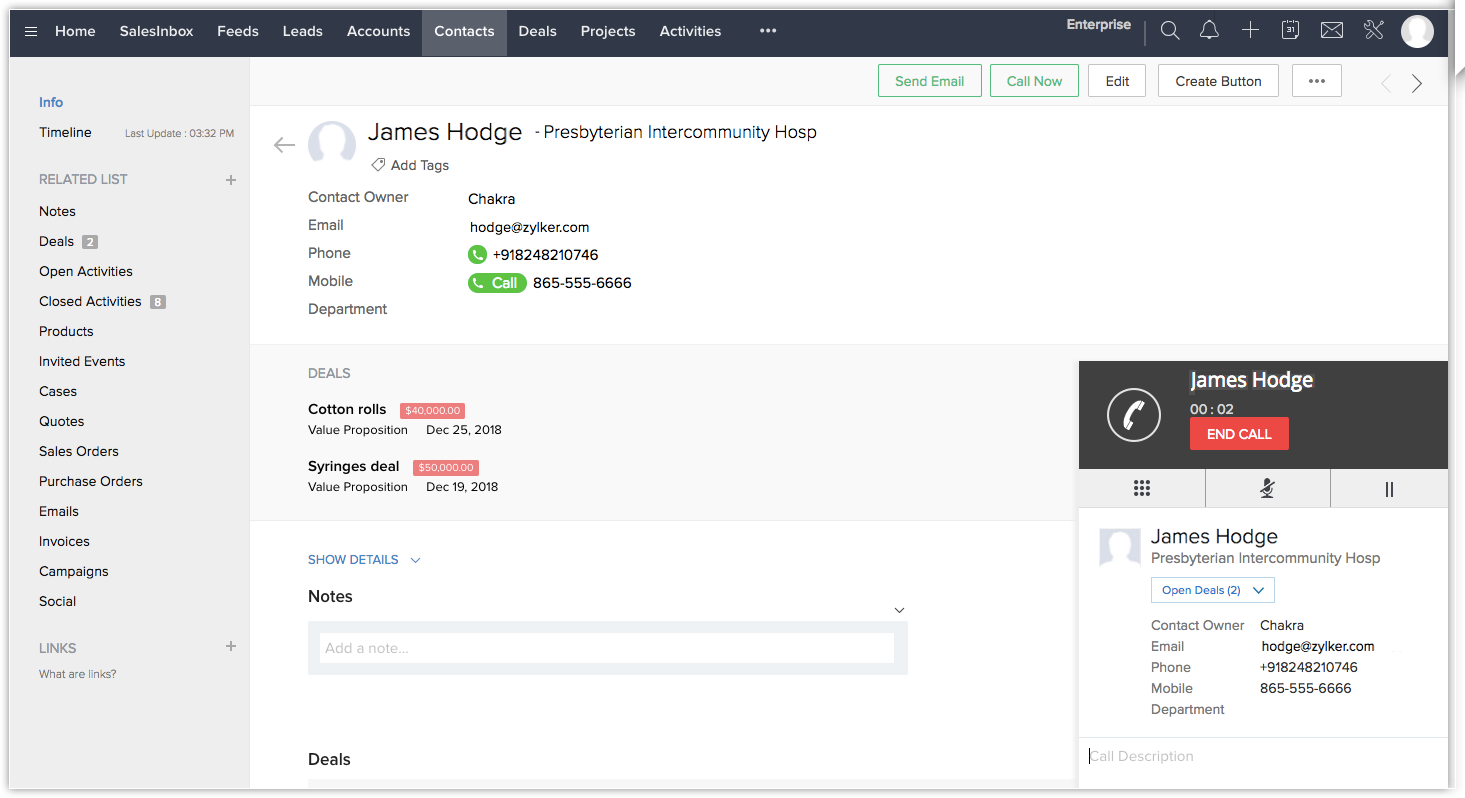

- Mute, Unmute, Hold, Unhold, and Dialpad functionalities will only be included in the pop up, if you choose the Browser option.
- Please refer to network connectivity functionalities before choosing the Browser option.
- Browser calling will be supported only in chrome 29 and above and firefox 47 and above.
Disable BT Cloud Phone Integration
The BT Cloud Phone Integration can be disabled at any time. Only the Administrator of a Zoho CRM account can disable the integration.
To disable BT Cloud Phone integration
- Go to Setup > Channels > Telephony.
- Click Disable.
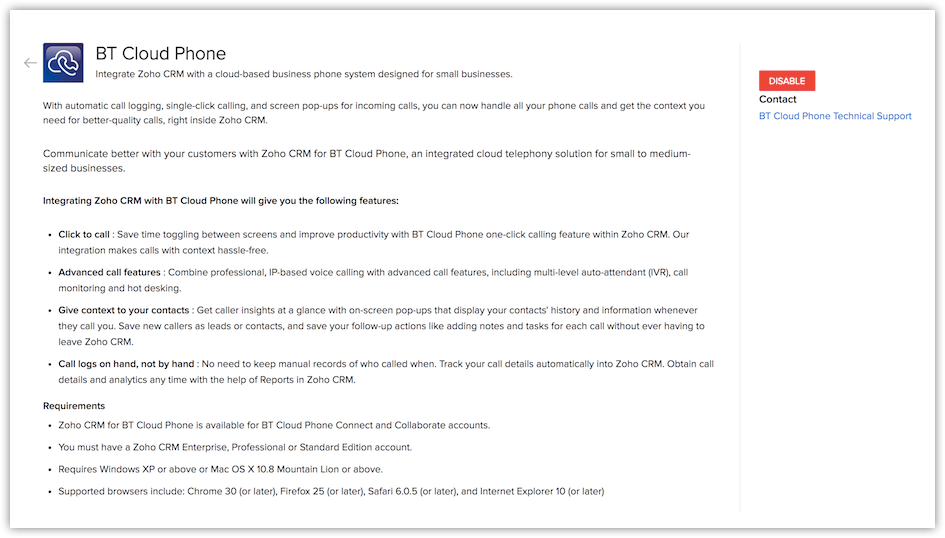

- On disabling the BT Cloud Phone integration, you will no longer be able to make calls in Zoho CRM via BT Cloud Phone.
- Once disabled by the Administrator, the integration is disabled for all users in the Organization account.
- Call details that were entered before the integration was disabled remain intact.
Browser Calling for BT Cloud Phone
Browser calling for BT Cloud Phone allows users to make calls directly from your CRM without having to toggle between the CRM account and BT Cloud Phone software. WebRTC plugins are installed to give hassle-free browser calling and a real-time communication with the end user.
Let’s take a look at the following network connectivity components that are required to be included in the user network.
Firewall Configuration
Firewall includes a Wide-Area Network interface such as a DSL, Ethernet or a cable modem. Firewall configuration allows outgoing TCP and UDP port control to the public Internet from the browser that uses the BT Cloud Phone client. It also enables the opening of ports so that the client server has time to exchange information with the remote server.
Router
Router provides routing, traffic directing, packet forwarding and also provides support for ping and traceroute ICMP, bandwidth management, packet prioritization and smart packet inspection.
Firewall Access
Firewall access ensures that the outbound and inbound firewall port is opened between the internal user network and the ISP WAN for the applications such as, Call control, RTP media, telephone provisioning and registration, and Auxiliary services. This firewall access allows the call control and media path connectivity.
WebRTC plugins
WebRTC helps realtime multimedia applications to function without any installation of additional extensions, or plugins. It enables Real Time Communication to the end user independent of the browser being used. The following are the ports to be opened before enabling the browser option under BT Cloud Phone call preferences.
| Traffic Type |
Protocols |
Source Port Number |
Destination Port Number |
| Signaling and (secured) Media (WebRTC) |
HTTP/TLS/TCP, STUN/UDP |
5060, 6182, 8080, 8083 |
5060, 6182, 8080, 8083 |
For more information on BT Cloud Phone network requirements, click here.
Zoho CRM Training Programs
Learn how to use the best tools for sales force automation and better customer engagement from Zoho's implementation specialists.
Zoho DataPrep Personalized Demo
If you'd like a personalized walk-through of our data preparation tool, please request a demo and we'll be happy to show you how to get the best out of Zoho DataPrep.
You are currently viewing the help pages of Qntrl’s earlier version. Click here to view our latest version—Qntrl 3.0's help articles.
Zoho Sheet Resources
Zoho Forms Resources
Zoho Sign Resources
Zoho TeamInbox Resources
Related Articles
BT Cloud Phone電話連携
BT Cloud Phone連携の設定 BT Cloud Phoneは、クラウドベースの電話システムです。中小企業がシステムの運用をせずに機能だけを使用できるように設計されています。BT Cloud Phoneを使えば、外出先でもオフィスと同じ環境で仕事ができます。BT Cloud PhoneとZoho CRMを連携すると、次のことが可能になります: BT Cloud Phone経由でZoho CRMの連絡先との間で通話を発着信するときに、Zoho CRMの連絡先の概要ビューを表示できます。 ...Zoom Phone
Zoom Phone is a cloud-based phone system, rich in features facilitating video and voice calls, messaging, meetings and much more, for businesses of different sizes. It includes the traditional PBX options to allow users to call and interact in new ...Attaching files from other Cloud Drives
Files can be attached to a record from other cloud drives into the Attachments related list. The list of supported cloud drives are: Google Drive, Box, and OneDrive. Note A file should not exceed 10MB Maximum of 5 files can be attached at a time. To ...Avaya Cloud Office Integration
Set up Avaya Cloud Office Integration Avaya Cloud Office cloud phone service harnesses the power of internet to form a suite of business communication features on a cloud-based phone system. You can manage calls, host audio and video conferences, ...MF Cloud Invoice Extension
This integration is supported for users in the US, and JP DCs. Scope: Money Forward Cloud Invoice is an online invoicing application designed to simplify and automate the process of creating, sending, and managing invoices. Integrating MF Cloud with ...















